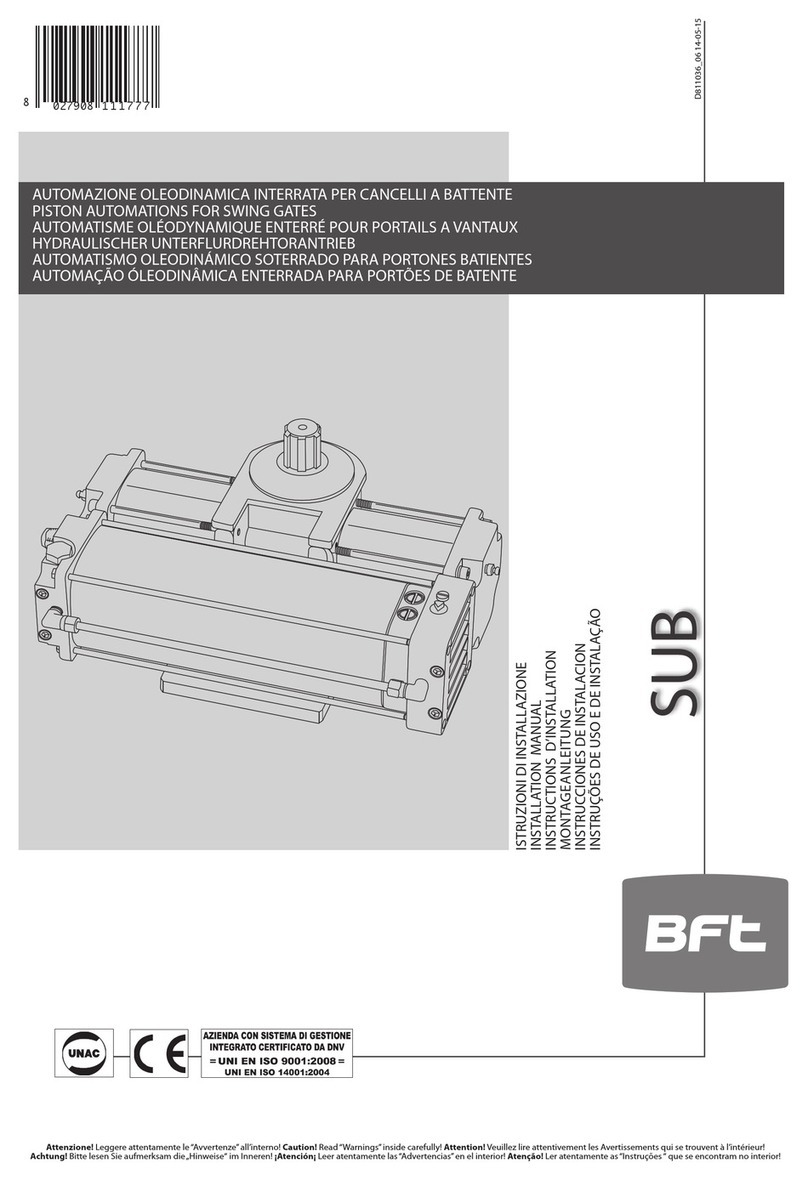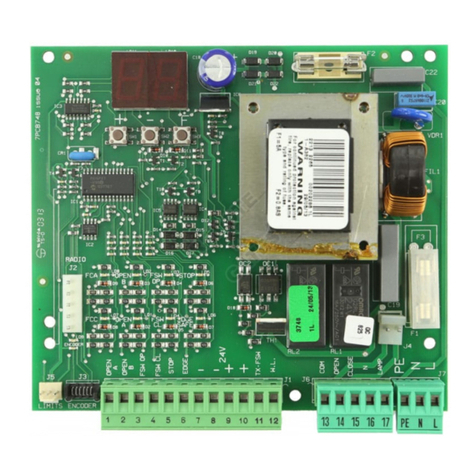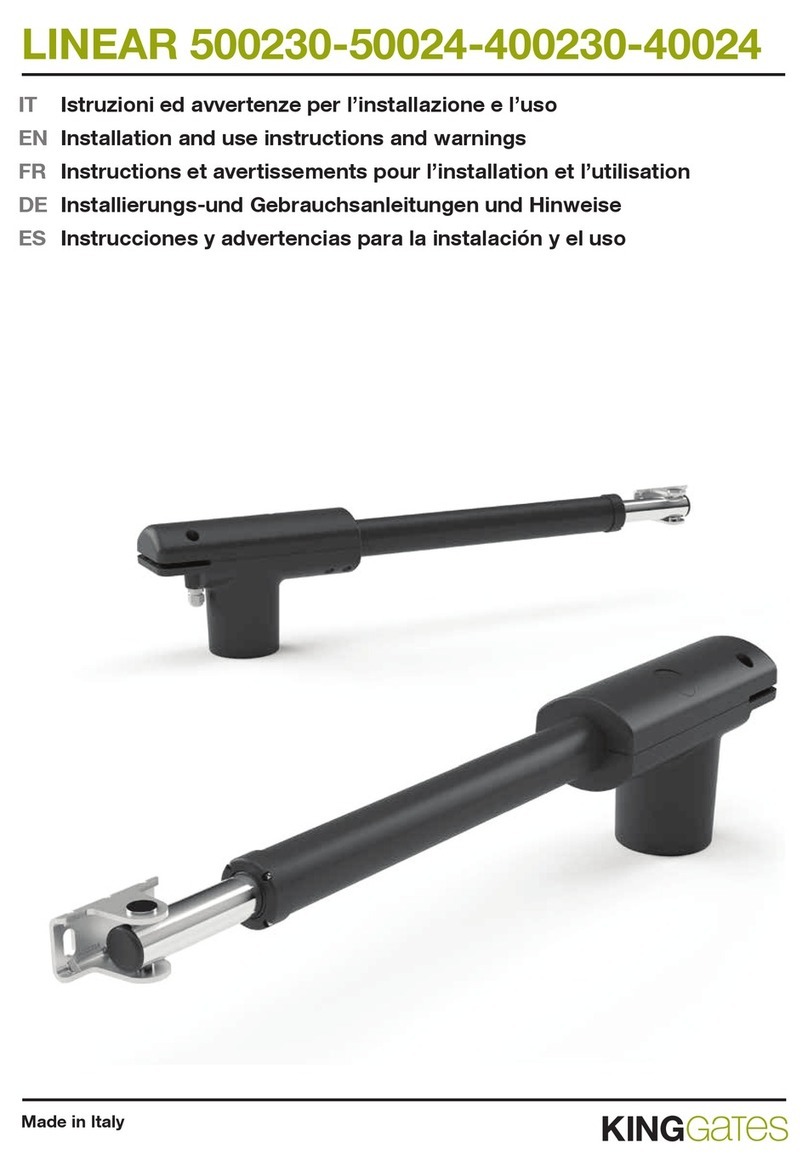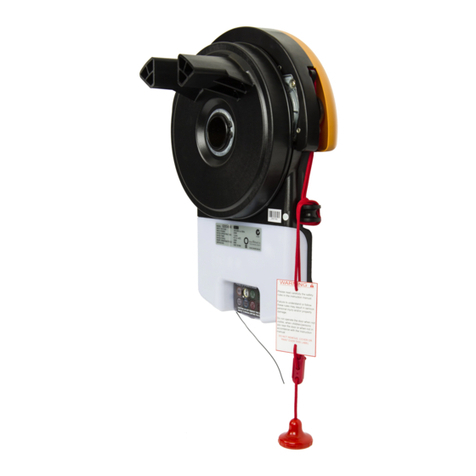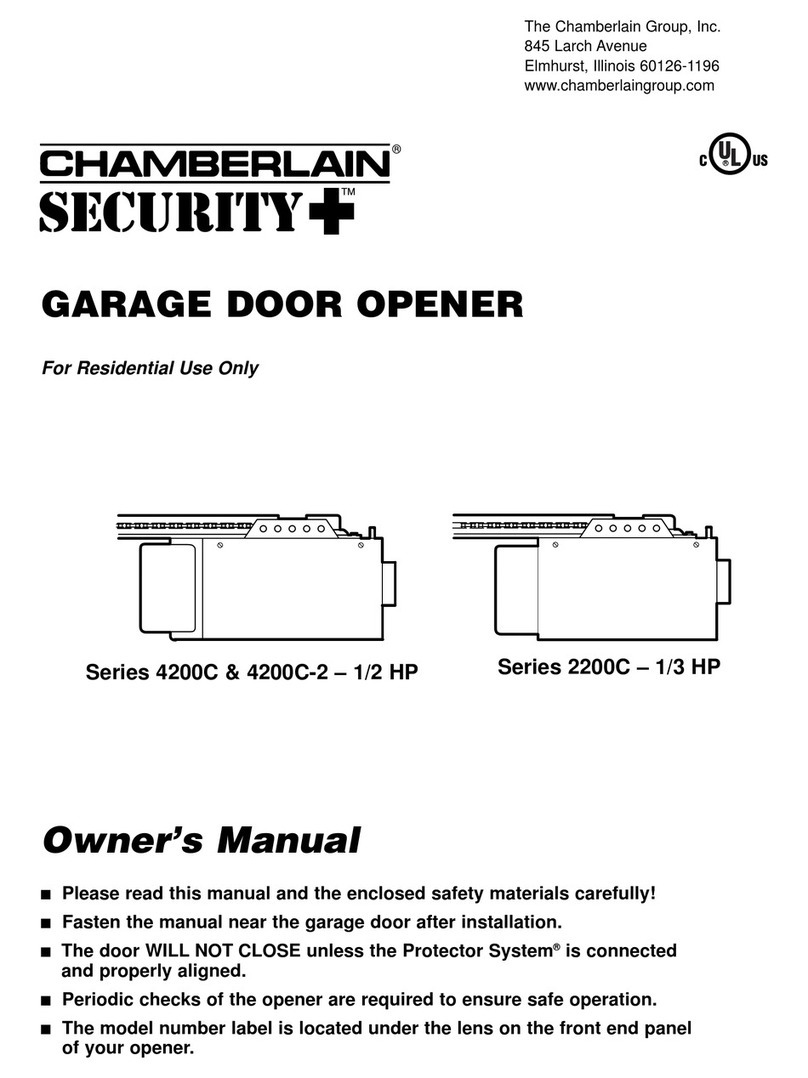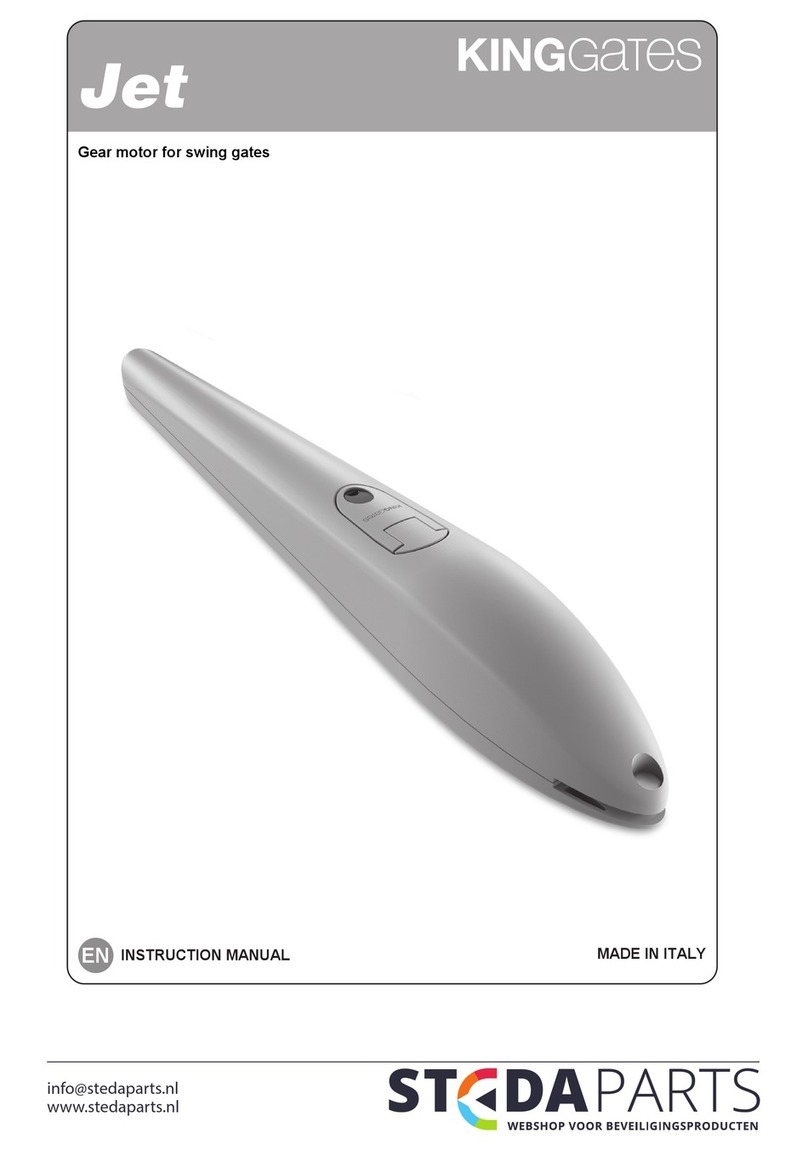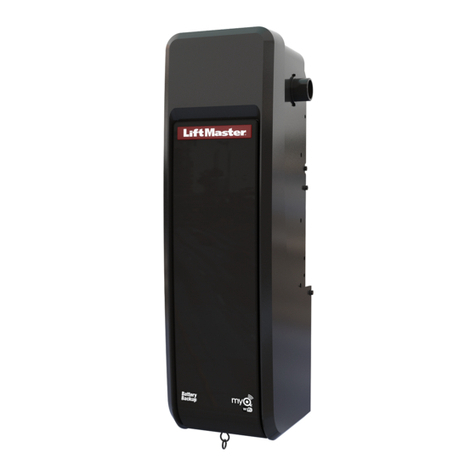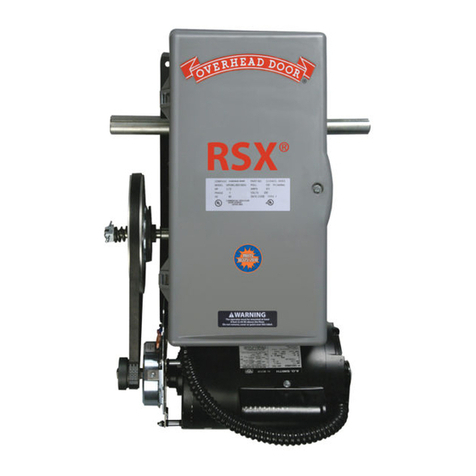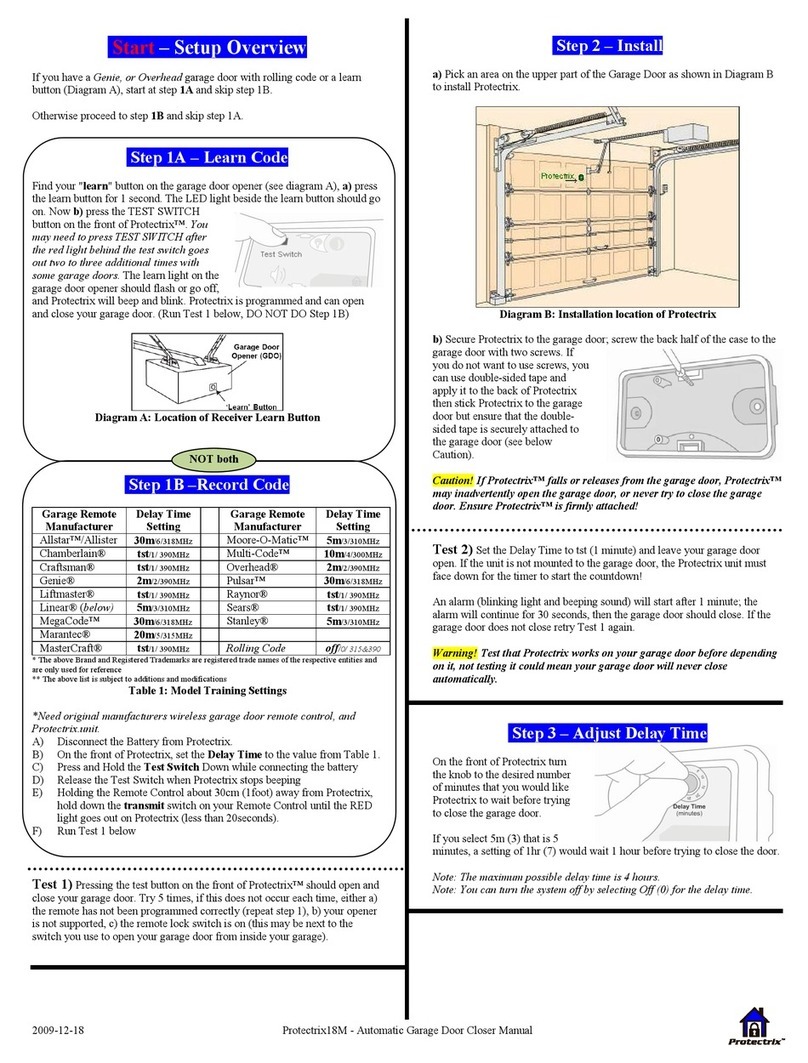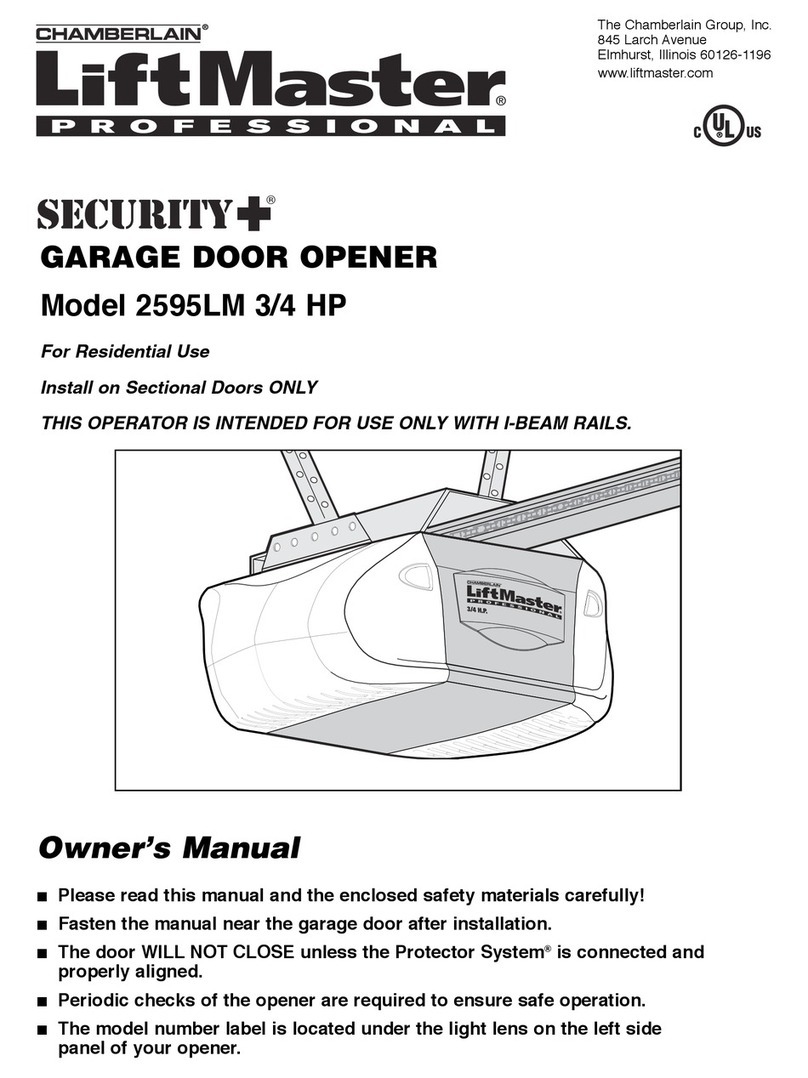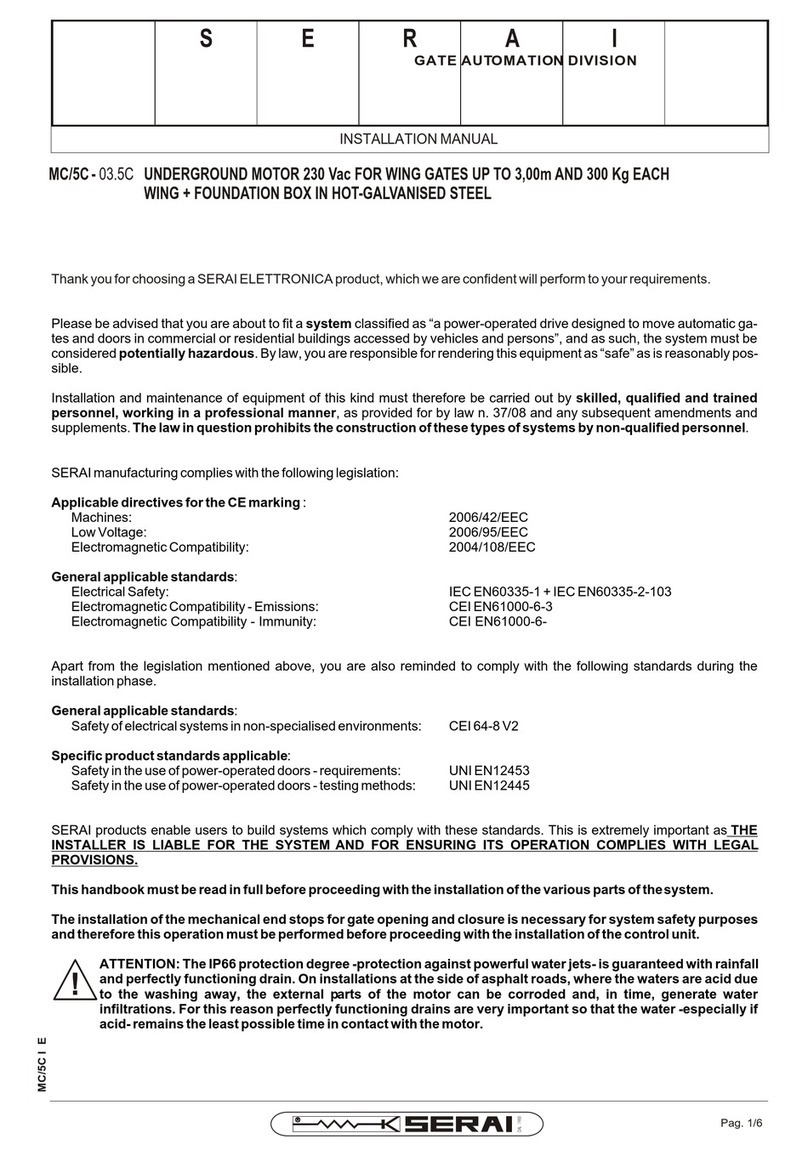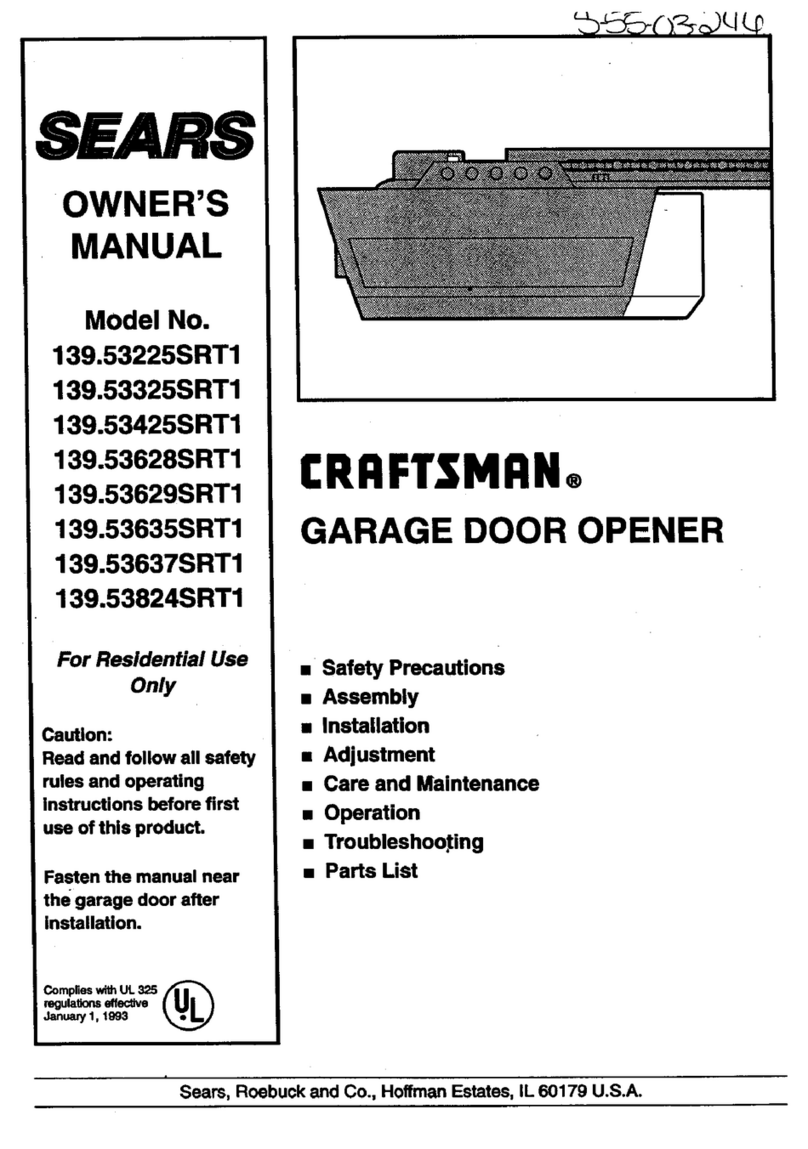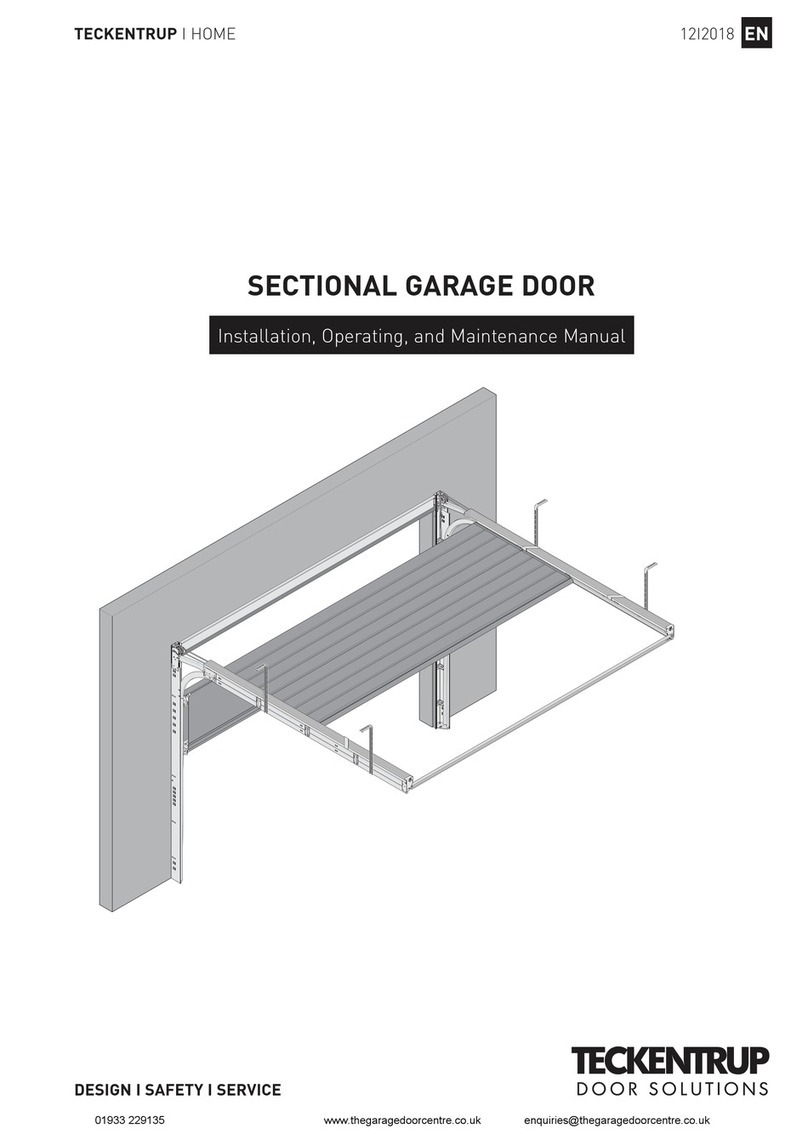Clopay EZ-SET Programming manual

EZ-SET®Torsion Spring System
Assembly Installation Instructions
EZ-SET®Torsion Spring
System Assembly
Installation Instructions
These instructions are to be used in conjunction
with your standard installation manual. Follow
the manual up through “Assembling & Installing
the Track” — except leave a minimum of 1/2" per
side between track and door, and just loosely
(temporarily) attach 3/8"-16 x 3/4" carriage bolt
in ag bracket.
Please read and understand these instructions
completely before proceeding with the instal-
lation of the EZ-SET®Torsion Spring System.
Carefully follow these instructions to avoid
personal injury or property damage.
Use these instructions for the EZ-SET®Torsion
Spring System only. (If you have regular
torsion springs, extension springs, or the
EZ-SET® Extension Spring System see the stan-
dard Installation Manual.)
Tools Needed
• 3/8" Medium duty reversible power drill
• 3/8" Open end wrench
• 3/16" Hex wrench
• 1/8" Drill bit
• 1/4" Insert bit (included)
In the interest of safety this symbol means
WARNING or CAUTION. Personal injury
and/or property damage may occur unless
instructions are followed carefully.
ALL REFERENCES TO LEFT HAND AND RIGHT HAND ARE MADE ASSUMING
THAT YOU ARE INSIDE THE GARAGE LOOKING OUT.

2
Parts List
TORSION
TUBE
(Full Length)
(If so equipped)
DESCRIPTION DOOR TYPE QTY.
WINDING
UNIT
BRACKET
DRUMS
TORSION
TUBE
(Half Length)
(If so equipped)
TUBE
COUPLER
(If so equipped)
END
BEARING
SUPPORT
Sngl. Car, Sngl. Spring
Dbl. Car, Sngl. Spring
Dbl. Car, Dbl. Spring
Sngl. Car, Sngl. Spring
Dbl. Car, Sngl. Spring
Dbl. Car, Dbl. Spring
Sngl. Car, Sngl. Spring
Dbl. Car, Sngl. Spring
Dbl. Car, Dbl. Spring
Sngl. Car, Sngl. Spring
Dbl. Car, Sngl. Spring
Dbl. Car, Dbl. Spring
Sngl. Car, Sngl. Spring
Dbl. Car, Sngl. Spring
Dbl. Car, Dbl. Spring
Sngl. Car, Sngl. Spring
Dbl. Car, Sngl. Spring
Dbl. Car, Dbl. Spring
Sngl. Car, Sngl. Spring
Dbl. Car, Sngl. Spring
Dbl. Car, Dbl. Spring
1
1
2
2
2
2
2
2
2
1
1
1
2
2
2
1
1
1
1
1
—
—
1
1
DESCRIPTION DOOR TYPE QTY.
LEFT SIDE
TORSION
SPRING
RIGHT SIDE
TORSION
SPRING
LAG SCREW
1⁄4" X 1"
SHEET MET-
AL SCREW
#14 X 5⁄8"
CARRIAGE
BOLT
3/8" - 16 X 3/4"
FLANGE
NUT
3/8" X 16
Sngl. Car, Sngl. Spring
Dbl. Car, Sngl. Spring
Dbl. Car, Dbl. Spring
Sngl. Car, Sngl. Spring
Dbl. Car, Sngl. Spring
Dbl. Car, Dbl. Spring
Sngl. Car, Sngl. Spring
Dbl. Car, Sngl. Spring
Dbl. Car, Dbl. Spring
Sngl. Car, Sngl. Spring
Dbl. Car, Sngl. Spring
Dbl. Car, Dbl. Spring
Sngl. Car, Sngl. Spring
Dbl. Car, Sngl. Spring
Dbl. Car, Dbl. Spring
Sngl. Car, Sngl. Spring
Dbl. Car, Sngl. Spring
Dbl. Car, Dbl. Spring
Sngl. Car, Sngl. Spring
Dbl. Car, Sngl. Spring
Dbl. Car, Dbl. Spring
1
1
1
—
—
1
2
2
2
4
4
4
2
2
2
4
4
4
4
4
4
2
2
2
NOTE: Doors greater than 10 feet in width are
double car doors.
LAG SCREW
5⁄16" X 15⁄8"
CENTER
SUPPORT
Sngl. Car, Sngl. Spring
Dbl. Car, Sngl. Spring
Dbl. Car, Dbl. Spring
SCALE
1⁄4
1⁄2
3⁄4 1" 2" 3"
Sngl. Car, Sngl. Spring
Dbl. Car, Sngl. Spring
Dbl. Car, Dbl. Spring
TUBE
RETAINER
NOTE: If you are missing any parts from
the parts list, do not return it to the store.
Please call the consumer support number
listed on the front page of your standard
installation manual.

3
Installing The EZ-SET®
Torsion Spring System
Step 1
Attach the bracket to the ag bracket and the
horizontal angle with a 3/8"-16 x 3/4" carriage bolt
and 3/8" ange nut. (FIG. 1, VIEW A) Be sure to
orient the carriage bolt and ange nut as shown in
Figure 1, Views A and B. Remove and reattach the
existing 3/8"-16 carriage bolt as required. The bracket
should be up against the jamb and the ag bracket.
If your door is 2" thick the carriage bolt should be
fastened through the slot in the ag bracket furthest
from the jamb. If your door is 13/8" thick the carriage
bolt should be fastened in the slot closest to the
jamb. If you have double track low headroom, see
Figure 2 for carriage bolt mounting locations. Do
this for both the left and right sides.
NOTE: Before installing 5/16" lag screws, it is
important to drill 3/16" pilot holes where the lag
screws are to be attached.
Use two 5/16" x 15/8" lag screws to connect the brack-
ets securely to the jamb or the header.
(FIG. 1, VIEW B) Install the lag screws in the
slots closest to the ag bracket if possible.
Before proceeding to Step 2, make sure the
carriage bolt(s) and the lag screws are fastened
securely and the bracket is seated against the
jamb and the ag bracket. Do this for both the left
and right sides. Solid attachment is critical since
these brackets will be under strong spring tension.
NOTE: If your torsion tube is one full-length
piece skip to Step 3.
Fig. 1
Flag
Bracket Jamb
Bracket
Horizontal
Angle
VIEW A
2" THICK DOOR (LEFT SIDE SHOWN)
12" RADIUS TRACK, USING SLOTS 1 AND 4
15” RADIUS TRACK, USES TOP TWO SLOTS
VIEW B
2" THICK DOOR (LEFT SIDE SHOWN)
12" RADIUS TRACK, USING SLOT 1
Existing
3/8" Flange
Nut
3/8" – 16 x 3/4"
Carriage
Bolt Bracket
Lag Screw
Jamb
Lag Screw
Fig. 2
Low Headroom
Starter Angle
Horizontal
Tracks
Bracket
Insert carriage bolts from
opposite side similar
to Figure 1B
Flag
Bracket
DOUBLE TRACK LOW HEAD ROOM
(LEFT SIDE SHOWN)
15" Radius
Track Slots

4
NOTE: Refer to standard instruction manual to
determine the radius of your track.
Step 2
Push the two torsion tube sections rmly into the
coupler.
NOTE: There are sets of two opposing holes
in each end of the coupler. When attaching the
coupler to each tube be sure to use the two
holes that are on the same side of the coupler
as shown in Figure 4.
After the tubes are inserted completely into the
coupler, drill one 3/16" pilot hole in each torsion
tube using the coupler holes as a guide. Fasten
the coupler to the tube with (2) #14 x 5/8" sheet
metal screws. (FIG. 4) Make sure the screws are
secure. Be careful not to over tighten screws, as
this could cause the hole to be stripped out.
IMPORTANT!
Step 3
Lay the spring(s) at on the oor. Measure the
length of each spring as shown in Figure 5, and
record each length in the space provided. You will
need to refer to this length in Step 7.
Fig. 4 TUBE COUPLER (IF SUPPLIED)
Tube
Coupler
Torsion
Tubes
#14 x 5/8" Sheet
Metal Screw
Fig. 5
Left Spring
Right Spring
Fig. 5A DETAIL VIEW
Set Cone
End of
Spring
End of
Spring
Spring Plug
Spring Plug
End of
Spring
End of
Spring
Left Side Spring Length
Right Side Spring Length
(RECORD LENGTH HERE)
(RECORD LENGTH HERE)
L-GREEN
R-ORANGE

5
TWO SPRING SYSTEM
Slide the spring(s), drums, winding unit(s), and
end bearing support (if supplied) onto the tor-
sion tube as shown in Figures 6 and 7. Alignment
may be required before the tube will pass through
spring spacer inside the spring.
If you have one spring see Figure 6 for the con-
guration of the components on the torsion tube.
The spring with "L-GREEN" stenciled on it and
green components MUST be put on the left side
of the tube. Make sure the end bearing support is
oriented so that the bearing is facing toward the
right drum.
If you have two springs see Figure 7 for the
conguration of the components on the torsion
tube. The spring with "L-GREEN" stenciled on it
and green components MUST be put on the left
side of the tube and the spring with "R-ORANGE"
stenciled on it and orange components MUST be
put on the right side of the tube. The torsion tube
coupler will be located between the two springs if
so equipped.
The drums should be oriented so that the slots are
facing away from the winding unit(s) and the end
bearing support (if supplied) as shown in Figure
8, Views A and B. The drums are designated as
left side and right side by the letters “L” and “R”
respectively found near the cable slot.
Fig. 7
Torsion
Tube
Right Side Winding
Unit (Orange Label)
Left Side Torsion Spring
(L-GREEN)
Left Side Drum
(Red)
Right Side
Drum (Black)
Right Side
Torsion Spring
(R-ORANGE)
Left Side Winding Unit
(Green Label)
VIEW B
RIGHT SIDE SHOWN
Fig. 8
View A
Left side shown
Letter “L”
Left Side Drum
(Marked with Red Paint)
Cable Slot
Left Side Wind-
ing Unit
Letter “R”
Right Side Drum
(Marked with Black Paint)
Cable Slot
Right Side Wind-
ing Unit
ONE SPRING SYSTEM
Right Hand
Drum (Black)
Set
Cone
End
Bearing
Support
Fig. 6
Left Side
Drum (Red)
Torsion
Tube
Left Side Wind-
ing Unit (Green
Label)
Left Side Torsion
Spring (L-GREEN)

6
NOTE: IF YOU NEED TO DISCONNECT THE
SPRING PLUG FROM THE WINDING UNIT
TAKE EXTRA CARE. To remove the spring
from the winding unit, two small at-headed
screwdrivers will be required. Two tabs must
be released, but only one tab is accessible at
a time. Depress the accessible tab with a small
screwdriver. To prevent the tab from re-lock-
ing, place a second screwdriver between the
spring plug and winding unit near the released
tab. Wind the winding unit until the other tab
can be accessed. Depress the second tab with
a small screwdriver. Make sure both tabs have
been released. Gently pull the spring from
the winding unit.
After all of the components are on the tube, the
spring plug should be inserted into the winding
unit. Ensure that the spring plug and the winding
unit have the same color code before snapping
them together. Line up both ears on the spring
plug with the two slots in the winding unit and
push them together. (Figure 9, Views B, C and D)
Slide the components toward the center of
the tube to expose 12" of each end of the tube.
Make sure that both ears of the spring plug are
fully intact and engaged into the winding unit
slots. Be certain that both of the tabs in the
winding unit slot engage with the spring plug
and that the connection between the spring
plug and the winding unit is secure before
proceeding.
Fig. 9
VIEW B
VIEW C
Winding Unit Label
Left Side (Green)
Left Side Spring
Plug Ear (Green)
VIEW D
Winding Unit
Slots & Tabs
Winding Unit Label
Right Side (Orange)
Right Side Spring
Plug Ear (Orange)
Winding Unit
Slots & Tabs
LEFT SIDE SHOWN
AFTER INSERTION
RIGHT SIDE SHOWN
BEFORE INSERTION
LEFT SIDE SHOWN
BEFORE INSERTION
Tabs
(Press Here
to Remove) Spring
Plug
Winding
Unit
Spring
VIEW A

7
Step 4
Carefully lift up the torsion tube and components
and place the ends of the tube in the cradle of
each bracket. Pull the tube away from the bracket
to slide the drum in between the bracket legs, and
engage the winding unit rails in the bracket slot.
(FIG. 10, VIEW A) Push the winding unit rails into
the bracket until the unit bottoms out.
If you have a door with two springs, go to the right
side and repeat the procedure for installing the
winding unit in the bracket.
If you have a door with only one spring, go to the
right side and install the end bearing support. The
end bearing support is installed in the same man-
ner as the winding unit. Pull the tube back just far
enough to place the drum between the legs of the
bracket. Do not pull the tube further than needed
to move the end bearing support and drum into
place, as damage may occur to a unit that is en-
gaged on the other side. Line up the
end bearing support rails (making sure that the
orientation feature is facing away from the brack-
et) and push it into the bracket until it
bottoms out. (FIG. 10, VIEW B)
Center the tube as equally as possible between
the brackets, so that an equal amount of the tube
is extending from each side.
Step 5 (Doors over 10' wide only)
NOTE: Before installing 1/4" lag screws, it is
important to drill 1/8" pilot holes where the lag
screws are to be attached.
Snap the center support onto the center of the
torsion tube (or coupler if present). Fasten the
support with two 1/4" x 1" lag screws to the header
above the center of the door. The lag screws
should be located at opposite corners of the
center support as shown in Figure 11. Position
and shim the mounting location as required to
make the tube straight. Check the distance from
the top of the door and the wall or header to the
tube along the length of the door to make sure the
tube is straight and level.
Fig. 11
Torsion
Tube
Lag
Screws
Header or Wood
Anchor pad
Coupler
Torsion
Tube
Fig. 10
VIEW A
LEFT SIDE SHOWN
Winding Unit
VIEW B
SINGLE SPRING – RIGHT SIDE SHOWN
Bracket
Bearing
Rails
Orientation Features
End Bearing
Support
Bracket
Bearing
Rails
NOTE: The drums and torsion tube are removed
from Figure 10, View A and Figure 10, View B
for clarity.
Center Support
(Required on doors
over 10' wide only)

8
Step 6
Install the included 1/4" insert bit (or a 7/16" socket)
in a medium duty drill: 1000-2500 RPM, (2-4 AMP)
variable-speed and reversible. Set the drill to
FORWARD (clockwise as you point the drill away
from you). Keep this drill and a 3/16" hex key handy
for Steps 8 and 9.
If the stripe on each spring is not facing toward
you as shown in Figure 12, engage the drill with the
1/4" insert bit (or 7/16" socket) into drive shaft of the
winding unit to rotate the spring until the stripe is
facing you. (FIG. 12)
NOTE: The 1/4" insert bit shown in Figure 12
is secured in a drill chuck, but the drill is not
shown.
IMPORTANT!
Step 7
Holding the tube in place, measure and adjust
the length of the spring to match the length you
recorded in Figure 5.
NOTE: THIS LENGTH SHOULD NOT BE LESS THAN
THE RECORDED LENGTH AND SHOULD NOT
EXCEED LENGTH BY MORE THAN 1/2"
DO NOT OVERSTRETCH SPRING(S) BEFORE
TIGHTENING SET SCREWS. Overstretching the
springs could cause the loss of spring tension
and possibly allow the door to fall. The length
of the spring on the shaft should NOT exceed
the relaxed spring length recorded in Step 3
on page 4 of the EZ - SET®Torsion Spring
System Instructions by more than 1/2" max.
NOTE: Be sure to hold the tube in position after
you have tightened the spring set screws. Any
sliding of the tube from this point on will affect
the length of the springs.
Tighten both set screws in the set cone to the tor-
sion tube. Use a 3/8" wrench if the springs are sup-
plied with square head set screws as shown
in Figure 13, View A. Use a 3/16" hex wrench if sup-
plied with internal set screws as shown in Figure 13,
View B. CAUTION: When resistance is encountered
while tightening the set screw, the screw has made
contact with the tube. Set screws should be turned
from 3/4to one full turn after they have made
contact with the tube. Additional turns may damage
the tube.
Fig. 13
View B
set cone shown with
internal set screws
View A
set cone shown with
square head set screws
External Set
Screws
Torsion Spring
Set Cone
Torsion
Tube
Internal Set
Screws
Torsion Spring
Set Cone
Torsion
Tube
Fig. 12
If you have a door with two springs, repeat the
above procedure for the right side spring.
Clockwise
Winding
Direction

9
Step 8
NOTE: Be careful not to shift the tube left or
right during this step as this will disturb the
gap set in the spring(s).
Starting with the left side, pull the lift cable up from
the safety bottom bracket behind the rollers and
inside of the jamb brackets. Bring it between the
legs of the bracket and behind the drum and insert
the cable lug into the drum slot. (FIG. 14, VIEWS
A & B) Make sure that both set screws are ush or
below the surface of the cable grooves BEFORE
securing the drum. Take up the cable slack by
turning the drum by hand. Make sure the cable is
pulled tightly into the drum grooves and the drum
is against the bearing in the winding unit, then
tighten the most accessible set screw in the drum
(only one of two need to be tightened) using a
3/16" hex wrench. CAUTION: When resistance is
encountered while tightening the set screw, the
screw has made contact with the tube. Set screws
should be turned from 3/4to one full turn after they
have made contact with the tube. Additional turns
may damage the tube. While maintaining cable
tension, use the drill (turning clockwise as in
Figure 12) to wind the spring 1 or 2 turns. The
spring tension will maintain the proper cable ten-
sion when you let go.
Go to the right side to secure the right side drum.
Pull the cable up between the legs of the bracket,
insert the cable lug in the drum slot, and take up
the cable slack by turning the drum. Before secur-
ing the right side drum, pull the tube toward the
right side to make sure there is no gap between
the left drum and left bearing. Slide the right drum
against the right bearing and secure the drum.
There should be 1/16" maximum gap between the
drums and the bearings on each side. Tighten the
most accessible set screw down to secure the
right drum using a 3/16" hex wrench. CAUTION:
When resistance is encountered while tightening
the set screw, the screw has made contact with
the tube. Set screws should be turned from 3/4to
one full turn after they have made contact with the
tube. Additional turns may damage the tube.
NOTE: Verify that the drum marked with the
letter “L” is on the left side (FIG. 14, VIEW A)
and the drum marked with the letter “R” is on
the right side. (FIG. 14, VIEW B)
Fig. 14
VIEW B
RIGHT SIDE SHOWN
VIEW A
LEFT SIDE SHOWN
Cable Lug
Letter “L”
Drum Slot
Drum Slot
Cable
Lug
Letter “R”
Set Screw
Location

10
Step 9:
Install the tube retainer as shown in Figure 15.
Attach the tube retainer to the EZ-SET®Torsion
Spring System bracket with a 3/8" - 16 x 3/4" car-
riage bolt. Be sure to position the carriage bolt
and ange nut as shown in Figure 15. Be sure to
install a tube retainer on both the left and right
sides of the door.
NOTE: Tube retainer may be periodically
lubricated with a light household oil if
squeaking occurs.
To avoid personal injury, do not rest hand
or any other part of your body on the spring
or any part of the EZ-SET®Torsion Spring
System while tensioning or untensioning the
spring.
During winding, operate the drill at HALF
SPEED until the required number of winds
is reached. If additional winding is required
or the system has to be completely unwound,
wait AT LEAST FIVE MINUTES between
consecutive winds/unwinds. If for any reason
the unit begins to resist winding STOP winding
at once and wait AT LEAST FIVE MINUTES
before continuing. Failure to follow these
instructions may result in damage to the
unit, the rapid release of spring energy, or
personal injury.
To remove ALL tension from the spring,
unwind (drill in reverse/counterclockwise) until
the spring paint stripe is a single
straight line and the lift cables are slack.
Only adjust the number of spring winds when
the door is completely closed.
Fig. 15
Tube
Retainer
Bracket
Carriage
Bolt and
Flange Nut
LEFT SIDE SHOWN

11
Step 10:
Engage the drill with the 1/4" insert bit (or 7/16"
socket) into the drive shaft of the winding unit to
wind the spring. See Table C for the total number
of winds required for your spring(s).
If you have a door with one spring:
After securing the left and right drums, nish
winding the left spring to the specied number of
winds.
If you have a door with two springs:
After securing the left and right drums, there will
be one or two winds on the left spring. Proceed
with winding the right side to the specied number
of winds. Go to the left side and nish winding
the spring to the specied number of winds.
The number of spaces between stripes on
the spring equals the number of winds on the
spring. (FIG. 16)
IMPORTANT: Lift the door 3"- 4" off of the
ground. Starting on the right hand side,
tighten the set screw that was not previously
tightened in Step 8. Repeat this procedure for
the left hand side.
The exact number of winds may be adjusted by
adding up to 21/4winds or subtracting 1/2wind
as compared to Table B. Lift the door by hand
with the automatic door opener disconnected
(if so equipped). If the door lifts by itself or lifts
too easily, reduce the number of winds (drill in
reverse/counterclockwise). If the door is too hard
to lift, increase (drill in forward/clockwise) the
number of winds.
Fig. 16
Stripe Space
(Example: Spring with 11 winds)
1 2 3 4 5 6 7 8 9 10 11
DOOR SPRING
HEIGHT WINDS
5'9" 93/8
6'0" 93/4
6'3" 101/8
6'6" 101/2
6"9" 107/8
7'0" 111/4
7'3" 115/8
7'6" 12
7'9" 123/8
8'0" 123/4
Note: 1/8 turn = 45°
45°
NOTE: If you have a door with two springs, each
spring requires the number of winds specied in
the table.
SPRING WINDING — TABLE C
IMPORTANT: Prior to opening your door for
the rst time or attaching an automatic door
opener, ensure that the door will clear the
brackets and winding unit(s). Failure to check
this could result in damage to your door and
opener! If the tracks are not correctly aligned
or the back hangers are not strong enough,
the door may fall. Proceed slowly and
carefully. Refer to the standard installation
manual before operating the door. Make sure
all applicable steps were performed from the
standard installation manual. For maintenance
of door and springing system, see the stan-
dard installation manual.

12
©2000 CBPC P/N 0130555 Rev. 11, 6/04
Table of contents
Other Clopay Garage Door Opener manuals


